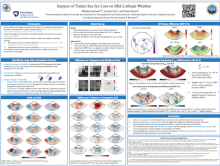Impacts of projected Arctic sea ice loss on daily weather patterns over North America
Melissa
Gervais
Penn State
Poster
Future Arctic sea ice loss has a known impact on Arctic Amplification (AA) and mean atmospheric circulation. Furthermore, several studies have shown it leads to a decreased variance in temperature over North America. In this study, we analyze results from two fully-coupled Community Earth System Model (CESM) Whole Atmosphere Community Climate Model (WACCM4) simulations with sea ice nudged to either the ensemble mean of WACCM historical runs averaged over the 1980-1999 period for the control (CTL) or projected RCP8.5 values over the 2080-2099 period for the experiment (EXP). Dominant large-scale meteorological patterns (LSMPs) are then identified using self-organizing maps applied to winter daily 500 hPa geopotential height anomalies (Z'500) over North America. We investigate how sea ice loss (EXP-CTL) impacts the frequency of these LSMPs and, through composite analysis, the sensible weather associated with them. We find differences in LSMP frequency but no change in residency time indicating there is no stagnation of the flow with sea ice loss. Sea ice loss also acts to de-amplify and/or shift the Z'500 that characterize these LSMPs and their associated anomalies in potential temperature at 850hPa. Impacts on precipitation anomalies are more localized and consistent with changes in anomalous sea level pressure. With this LSMP framework we provide new mechanistic insights, demonstrating a role for thermodynamic, dynamic and diabatic processes in sea ice impacts on atmospheric variability. Understanding these processes from a synoptic perspective is critical as some LSMPs play an outsized role in producing the mean response to Arctic sea ice loss.

gervais-melissa-polar-poster.pdf
(3.67 MB)
